Steroids
Why Use Antioxidants During a Steroid Cycle.

Antioxidants During a Steroid Cycle
Steroids are synthetic hormones designed for clinical use in managing various chronic diseases. Anabolic-androgenic steroids, derivatives of the male hormone testosterone, are used by athletes in sports. The aim in such instances is to boost muscle mass and increase performance and endurance. Also, they shorten recovery time between exercises. Inappropriate use of steroids is associated with several adverse effects. Their correct use is recommended to limit such outcomes, and antioxidants can help you.
Due to the varied uses and different desired outcomes, patterns of use have been established; cycling, stacking, and pyramiding. The steroid cycle refers to a pattern of steroid use intending to build body or muscle mass. Here, anabolic androgenic steroids are used in six to twelve weeks, followed by an off phase of several months. Pyramiding generally involves gradually increasing the dose of the steroids to a maximum level, followed by dose reduction. Another pattern is stacking, where various steroid combinations include other supplements.
Steroids in Sports
Athletes' desired outcomes categorize steroids as either bulking steroids- used to increase muscle mass or performance steroids- aimed to increase strength and endurance. Or cutting steroids- used to reduce weight (cut fat). Delivery routes are based on user preference and desired outcome. It can be oral, implants, injections, and creams or gels. They bind to the androgen receptors in the body, resulting in molecular interactions with the cell DNA. The ultimate result is to increase protein synthesis and subsequent cell growth.
Related Article:: How Can Steroids Affect Athletes – Benefits and Side Effects of Steroids
Cycles for anabolic steroid use depend on the physical state of the user. Beginners and experienced users have different cycles. This limits the chances of developing adverse outcomes; for instance, it lowers the risk of suppressing one's hormone production. Also, it enhances higher efficiency and safety. An example of a steroid cycle for beginners includes turinabol 30-50mg/day for 9 weeks, testosterone enanthate 500mg/week for 8 weeks, and Dianabol 30-50mg/day for 6 weeks. Experienced athletes' cycle contains a combination of steroids, for example, nandrolone decanoate +sustanon, trenbolone enanthate plus testosterone, and boldenone plus testosterone enanthate.
Related Article:: 10 Steroid Cycles for Different Goals (Newbie, Bulking, Cutting, Strength)
What are Antioxidants?
Antioxidants are substances or elements that inhibit or reduce cell damage due to free radicals, reactive oxygen species, and other unstable molecules resulting from chemical reactions or physiological changes in the body. During a steroid cycle, antioxidants play a role in scavenging free radicals and other unstable compounds produced by skeletal muscles during exercise.
- The roles played by these antioxidants include;
- Prevent oxidative stress.
- Reduce exercise-induced muscle damage.
- Increase muscle endurance.
- Shorten the recovery time after exercise.
- Counteract neutrophil inflammatory response.
The roles listed above are discussed in detail as follows. Later, I will discuss various classes and types of antioxidants available.
Antioxidants Counteract the Effect of Oxidative Stress.
Antioxidants cushion the oxidative stress sequelae. Physical exercise increases the production of reactive oxygen species, nitrogen species, and free radicals and their accumulation within the muscle mass. A sustained balance between oxidation and reduction is important in maintaining muscle physiology. These reactive oxygen species comprise superoxide anions, hydroxyl radicals, and peroxyl radicals.
>> Super ANTIOXIDANTS <<
Oxidative stress results from an imbalance between free radical production and the eliminating of physiological antioxidants. This imbalance with increased radical levels accounts for oxidative damage. Stress-sensitive signal pathways are activated, which play a role in the pathogenesis of chronic conditions such as cardiovascular conditions, metabolic syndrome, and insulin resistance.
Physical exercise's physiological importance in maintaining normal body function and health is accompanied by oxidative stress induction. During physical exercise, there is an increased demand for oxygen in the muscle tissue. It is estimated that oxygen uptake by the muscles increases by 10-20 folds. This increased influx in active skeletal muscles increases the formation of reactive oxygen species and free radicals. Their effect is to oxidize macromolecules, DNA, amino acids, polyunsaturated fatty acids, and proteins.
Basis of Antioxidants
The oxidized molecules form the basis for the development of chronic diseases. Reactive oxygen species accumulation results in muscle dysfunction and damage, prolonging recovery time. Antioxidants must counter these effects by eliminating formed reactive oxygen species and free radicals.
>> NOW Super ANTIOXIDANTS <<
Increased muscular activity is accompanied by increased metabolic rate and increased oxygen consumption by muscle fibers. This results in a subsequent temperature increase and reduced cellular muscle mass pH. These changes enhance free radicals' formation and accumulation in the muscle cells. Antioxidants protect the body from oxidative damage by reactive oxygen species and free radicals. Antioxidants protect against muscle damage.
During the steroid cycle, muscular activity increases with increased exercise levels. During this activity, muscle fibers stretch as a result of repeated use. Repeated contractions and relaxation create tension in skeletal muscles, causing the fibers to lengthen. Physical exercise increases oxygen influx within the muscle tissue. These active muscle fibers increase in size approximately by 100-200 folds. Normally, muscle fibers are adaptive to the level of stress experienced.
However, increased activity increases the production and accumulation of free radicals and reactive oxygen species. Their formation rate exceeds that of clearance by available antioxidants, both exogenous and endogenous systems. Their formation plays a role in muscle damage during physical activity. Antioxidants remove the reactive oxygen species, thus halting further muscle damage. A study by Cian McGinley et al. 2009 evaluated vitamin C and E's role in preventing muscle damage due to ROS due to exercise among sportspersons.
New studies on Antioxidants
The study used various supplementation mechanisms with variations in dosing, timing, and duration. The study's outcome showed that antioxidants reduce oxidative stress with a minimal role in preventing muscle damage. A similar study by Vilma Simoes Pereira et al. in 2015 aimed to find the effects of supplementation with dietary antioxidants on recovery following exercise-related muscle damage.
>> Solgar Antioxidant Formula <<
Dietary supplementation of phytochemicals has been shown to reduce the effects of eccentric muscle damage due to exercise. Another study explained the findings above, emphasizing that the correct dosage and requirement should be provided to avoid toxicity or causing further muscle damage. An individual estimated requirement must be provided for muscle tissue's effective functioning and a better outcome.
Role in Modulating Inflammatory Response.
During the steroid cycle, individuals are involved in strenuous physical exercise. This activity alters the skeletal muscle state by increasing the length and that of tendons. This is a result of the adaptive activity of the muscle tissue to exercise, as discussed above. In the process, there is a muscle injury, which will trigger an inflammatory response. Muscle damage also results from the thermal effects and ischemia/reperfusion. Neutrophil leads to the accumulation of reactive oxygen species, thus increasing the burden of oxidative stress in the muscle cells.
Neutrophils are increased in circulation during exercise. Their increase subsequently increases the level of neutrophils associated with reactive oxygen species and corresponding oxidative stress. Another source of neutrophils during exercise is suggested to be the effect of free radicals on leucocytes, where they damage the DNA. A study confirmed that antioxidants modulate the neutrophil inflammatory response to exercise-induced stress.
>> Pure Antioxidant Formula <<
In that study dated December 7th, 2020, three groups were studied for 21 days. One group was on the antioxidant-supplemented beverage, and the others acted as control groups. Blood samples were drawn at the end of the exercise, and plasma and neutrophils were separated. Plasma creatinine kinase and myoglobin levels have elevated a confirmation of muscle damage due to exercise.
After measuring plasma oxidative bio-markers, it was found that it increased in all the groups, not on antioxidant supplements. On measuring neutrophil antioxidant enzymes, there was a notable increase in the control groups, confirming that the activity was reduced in the supplemented group. The activity of myeloperoxidases was increased significantly among the control groups. On the other hand, enzyme levels were elevated among those on antioxidant supplements. This confirmed the role of antioxidants in modulating inflammatory responses induced by exercise.
Increase muscle endurance and recovery and reduce recovery time.
Selected antioxidants have been shown to increase muscle endurance by reducing the delayed onset of muscle soreness. Polyphenols and other commercial antioxidants have been shown to have a moderate to good effect in lowering the delayed onset of muscle soreness. Other antioxidants have been shown to affect post-exercise muscle recovery positively. The ROS-scavenging effect of antioxidants reduces the number of free radicals and reactive oxygen species in skeletal muscles during exercise. These changes reduce muscle damage and thus increase muscle endurance during exercise. The formation of free radicals within the skeletal muscle has beneficial effects—the produced reactive oxygen species act as signaling pathways to enhance muscle protection from further physical stress.
Antioxidants
As defined above, they are free radical scavenging molecules. The overall effect of this function in to protect the cells from oxidative stress-induced damage. Their interaction with free radicals results in a chemical reaction that stabilizes these free radicals. In other words, the molecules can prevent oxidation or limit oxidation of other molecules. Oxidation refers to a chemical reaction that involves the transfer of electrons from one compound or element to the other (oxidizing agent).
>> Bluebonnet Antioxidant Formula <<
These reactions act as a source of free radicals, which start a chain of other harmful reactions to the cells. Antioxidants are mostly reducing agents in nature, thus preventing oxidation reactions by them getting oxidized in the process. A lack of antioxidants in the body or their limited availability will result in an oxidative stress state. This state is associated with a series of reactions that damage the cells and compromise function. Free radicals are associated with the pathogenesis of chronic diseases, for instance, cardiovascular diseases and cancers. Supplementation of antioxidants is beneficial because it provides the body's optimal physiological function and improves health.
Antioxidants can be endogenous or exogenous. Physiological antioxidants are naturally present in the body and comprise superoxide dismutase, catalase, and glutathione peroxidase. Exogenous antioxidants must be provided through an antioxidant-rich diet, synthetic antioxidants, and other supplements. Examples include thiols, vitamins C, E, and A, and polyphenols. Antioxidants can also be grouped as: 1. Natural antioxidants (primary), and 2. Synthetic antioxidants (secondary).
Primary antioxidants (free radical scavengers)
These antioxidants stabilize free radicals. They achieve this by breaking the chains of lipid radicals and converting them to a non-radical state or stable form. This group comprises antioxidants derived from phenols and secondary aromatic amines. Their structure makes them available in different molecular weights. They are further grouped as either mineral antioxidants, vitamin antioxidants, or phytochemicals. The mineral antioxidant serves as co-factors to enzymes involved in the anti-oxidation process. They comprise selenium, iron, zinc, magnesium, and copper.
>> Sambucus Advanced Formula <<
Their availability plays a bigger role in macromolecules' metabolisms, such as proteins and carbohydrates. Vitamins and antioxidants are vitamins that act as reducing agents. This comprises vitamins B, C, and E. Antioxidants that cannot be grouped as minerals or vitamins fall in the phytochemical category, including flavonoids. They are phenol compounds responsible for the coloration of plants, i.e., fruits and vegetables or seed leaves.
The most active in this group are catechins found in green tea and sesamol. The fat-soluble color of vegetables and fruits forms carotenoids. An example is beta-carotene, which is found in carrots in the body. It serves as a source of vitamin A in case of deficiency. Tomatoes have lycopene as an antioxidant, while dark green vegetables have zeaxanthin.
Secondary Antioxidants (peroxidase scavengers)
Unlike primary antioxidants, these function by reducing or decompressing hydroperoxides into stable compounds before transforming into active free radicals and stopping the chain reaction. The action can be combined with primary antioxidants for synergism and effective oxidative stress management. Examples include; Nordihydro garlic acid, tertiary butyl hydroquinone, butylated hydroxytoluene, propyl gallate, metal chelating agents, and butylated hydroxyanisole.
Sources of antioxidants.
The leading source of antioxidants is fruits and vegetables. Antioxidants are also available in nuts, grains, and animal proteins. Alpha-tocopherol is found in sunflowers, almonds, corn, broccoli nuts, and mangoes. Vitamin A-rich foods include liver, sweet potato, carrot, milk, egg yolk, and cheese. Ascorbic acid is found in most fruits and vegetables.
>> NOW E-400 <<
Color-containing fruits and vegetables, especially oranges color, are rich in beta-carotene. Green vegetables have an abundance of lutein and zeaxanthin. Tomatoes and their products contain high levels of lycopene. Mineral antioxidants are provided as supplements or other available in plants and animals, for example, selenium (rice and wheat).
Properties of antioxidants
Antioxidants used mostly are phenol compounds, either monohydroxyl or polyhydroxy. Due to their low activation energy, they are not reduced (they would not donate hydrogen). As a result of this stabilization, it prevents the formation of other free radicals. A free radical chain reaction is minimized by donating hydrogen by the antioxidant. The intermediate antioxidant free radical does not oxidize due to its stability, thus preventing free radical chain reaction propagation. The resultant antioxidant radical can also react with lipid-free radicals, and a complex compound is formed, which is stable, thus preventing further damage by such radicals.
Examples of antioxidants
Vitamin E (tocopherol): this is a fat-soluble antioxidant. Among the eight members of this group, alpha-tocopherol is the most important. It is the most lipid-soluble and enhances the membranes' protection from lipid-related free radicals resulting from lipid peroxidation chain reaction. The intermediate of this reaction, oxidized alpha-tocopherol, can be recycled to its original form using other antioxidants, e.g., vitamins A and C.
>> Gamma E Complex <<
Vitamin C has reducing properties, can neutralize reactive oxygen species, and plays a vital role in cancer prevention. Its reaction with glutathione within the cell maintains it in a reduced state.
Glutathione is synthesized in the cells from amino acids. It can be maintained within the cell in either reduced or oxidized states mediated by enzymes such as glutathione reductases. It maintains the cell in its redox state, and due to its high concentration, it is the most vital cellular antioxidant. The cysteine group has reduction properties in its structure and can be oxidized reversibly.
Adverse effects of antioxidants
- Toxicity in case of antioxidant overdose.
- Reactive oxygen species (ROS) regulate cell adhesion, and their elimination compromises this.
- ROS regulates the MAPK pathway for DNA repair. antioxidants actions will inhibit DNA repair and apoptosis
- Immune system activation depends on ROS, and so does inflammatory response induction.
- ROS plays a role in killing phagocytosed microbes by macrophages. Their elimination by antioxidants will impair this role.
- Activation of the extracellular microbes depends on superoxide and nitric oxide, which eliminate antioxidants.
Conclusion
Contrary to what many people think about antioxidants, they’re, in fact, beneficial to a bodybuilder or any other fitness enthusiast during a steroid cycle. However, it would help if you regulated it to reap the full benefits.
Steroids
Decoding IGF-1 LR3: A Guide to its Benefits
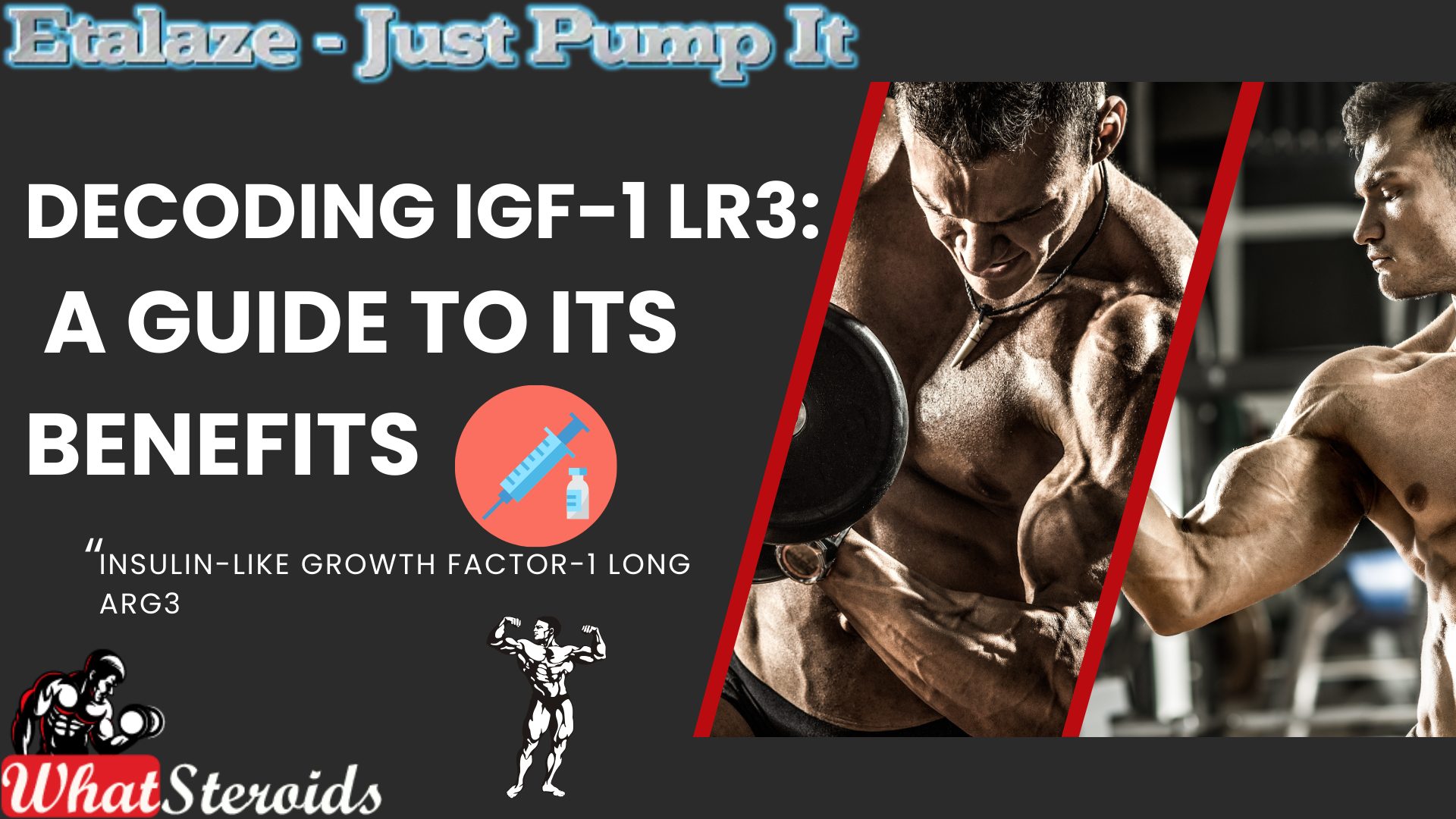
IGF-1 LR3 (Insulin-like Growth Factor-1 Long Arg3) is a synthetic variant of IGF-1, a hormone produced by the liver in response to growth hormone (GH). Unlike GH, which works indirectly, IGF-1 directly facilitates the growth and repair of muscle cells.
Related Article: Ostarine for Beginners; The Ultimate Guide
This modified version of IGF-1 is engineered to avoid binding with IGF-binding proteins, extending its half-life to 20–30 hours. As a result, it remains active in the body significantly longer than natural IGF-1.
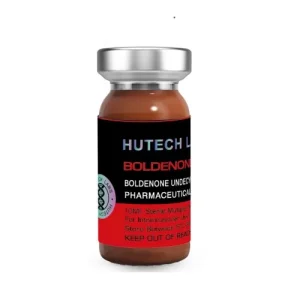 Click here to BuyBoldenone 300 by Hutech
Click here to BuyBoldenone 300 by Hutech
Many performance athletes incorporate IGF-1 LR3 post-workout to enhance muscle growth, speed up recovery, and support fat loss. When injected into specific muscle groups, it often produces localized effects. Additionally, it helps with nutrient distribution and, in some cases, improves insulin sensitivity.
On the other hand, human growth hormone (HGH) operates more broadly and indirectly, stimulating the liver to produce IGF-1 and offering more systemic benefits such as improved skin health, joint support, and fat reduction, albeit at a slower pace.
Typical IGF-1 LR3 doses range from 20–50 mcg daily, administered subcutaneously or intramuscularly, often following a workout.
Key Features of IGF-1 LR3
Enhanced Bioavailability: It avoids binding with IGF-binding proteins, increasing its potency.
Muscle Growth & Repair: Directly stimulates muscle cell proliferation and differentiation.
Improved Nutrient Distribution: Helps shuttle nutrients into muscle cells, supporting recovery.
Potential Fat Loss Benefits: Some users report improved insulin sensitivity and fat metabolism.
Mechanism of Action
IGF-1 LR3 interacts with IGF-1 receptors on muscle cells, activating pathways like PI3K-AKT and MAPK, which are crucial for cell growth and regeneration. This makes it a powerful tool for bodybuilders and athletes looking to optimize recovery and muscle development.
What Are the Top 10 Alternatives to IGF-1 LR3?
Here are some of the top alternatives to IGF-1 LR3, each with unique benefits for muscle growth, recovery, and performance:
BPC-157 – Known for its regenerative properties, it enhances healing and tissue repair.
CJC-1295 – A growth hormone-releasing peptide that boosts GH levels for muscle development.
Ipamorelin – Stimulates GH release with minimal side effects, making it a safer option.
MK-677 (Ibutamoren) – A potent GH secretagogue that promotes muscle growth and fat loss.
Sermorelin – Encourages natural GH production, supporting recovery and lean muscle gains.
Tesamorelin – Primarily used for fat loss, but also aids in muscle preservation.
Follistatin-344 – Inhibits myostatin, allowing for increased muscle hypertrophy.
PEG-MGF (Pegylated Mechano Growth Factor) – Enhances muscle repair and growth post-exercise.
GHRP-6 – Stimulates appetite and GH release, supporting muscle mass gains.
GHRP-2 – Similar to GHRP-6 but with fewer hunger-related side effects.
Each of these peptides has distinct mechanisms and benefits.
Must Read: Are Nootropics a Better Option to AAS?
Potential Risks Associated With IGF-1 LR3
IGF-1 LR3 comes with several potential risks, especially for bodybuilders using it to enhance muscle growth. Here are some key concerns:
Hypoglycemia (Low Blood Sugar) – IGF-1 LR3 increases glucose uptake in muscle cells, which can lead to dangerously low blood sugar levels if not managed properly.
Organ Growth – Since IGF-1 affects all tissues, excessive use may lead to unwanted growth in organs, increasing health risks.
Cancer Risk – IGF-1 plays a role in cell proliferation, and elevated levels have been linked to an increased risk of certain cancers.
Water Retention & Edema – Some users experience bloating and fluid retention, which can affect performance and aesthetics.
Joint Pain & Stiffness – Excessive IGF-1 levels may contribute to joint discomfort due to increased tissue growth.
Cardiovascular Issues – There is some concern that IGF-1 LR3 could contribute to heart enlargement or other cardiovascular complications.
Desensitization – Long-term use may reduce the body's natural IGF-1 production, leading to dependency
Overall
IGF-1 LR3's ability to bypass IGF-binding proteins makes it more potent but also increases the likelihood of desensitization with prolonged use. For those considering it, careful dosing and monitoring are crucial to mitigate side effects.
Steroids
AOD-9604: The Fat-Burning Peptide Explained
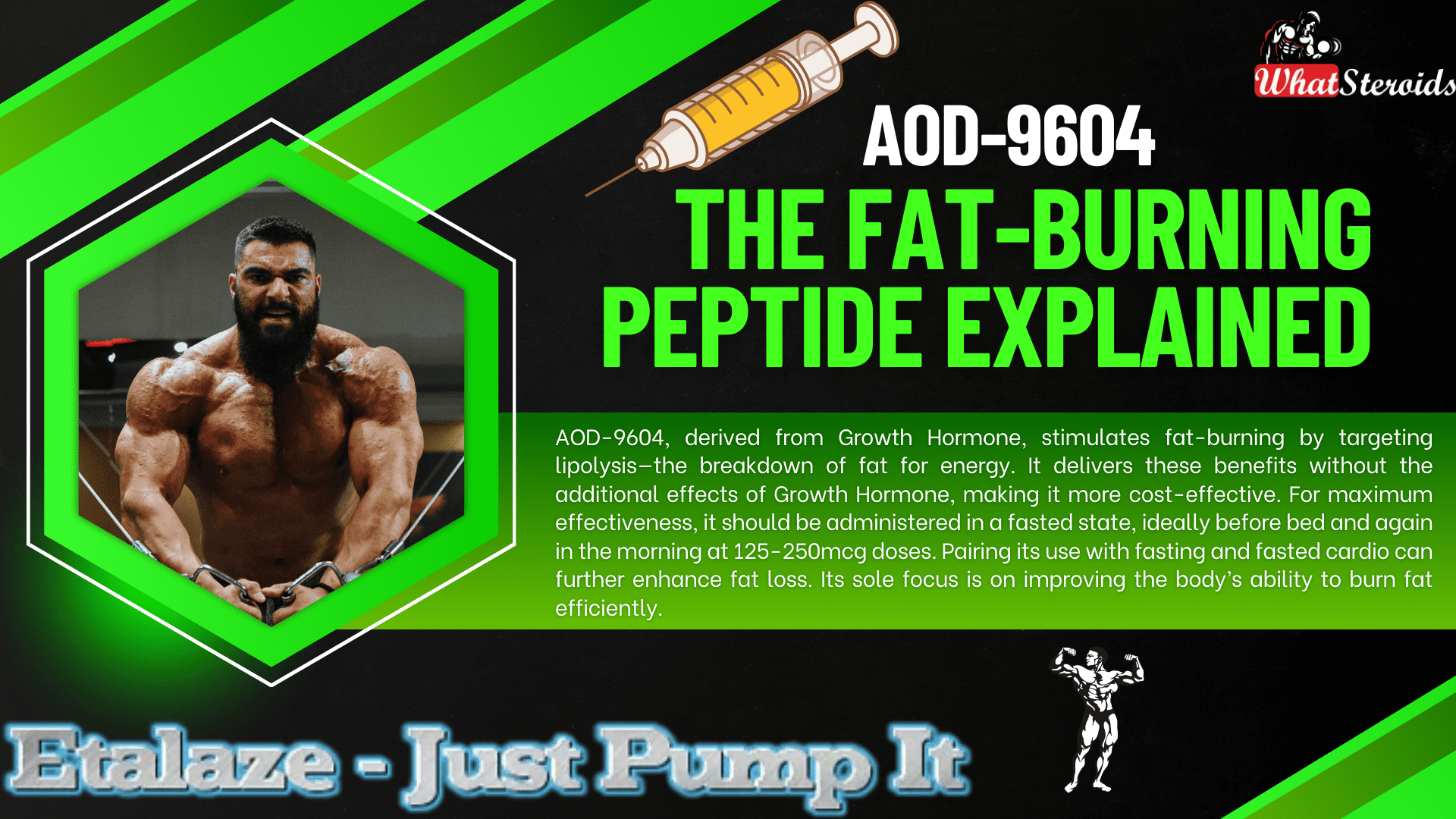
AOD-9604, along with the similar HGH Frag 176-191, is a peptide derived from Growth Hormone that includes only the amino acids in HGH responsible for stimulating fat breakdown, known as lipolysis.
This means that these peptides offer the fat-burning benefits of HGH without its other effects—whether beneficial or adverse—and come at a lower cost.
Related Article: Anavar Cycle for Men and Women
Lipolysis refers to the process where fat cells are broken down to be utilized as energy. AOD-9604 promotes accelerated fat loss by increasing the body's use of fat as fuel.
For optimal results, the peptides should be used in a fasted state. AOD-9604 and Frag 176-191 are most effective when administered at a dose of 125-250mcg before bedtime (at least 3-4 hours after eating) and in the morning at the same dose, followed by a fasting period of 3-4 hours, ideally combined with fasted cardio.
Check Out Dragontropin HGH 100 IU by Dragon Pharma
Similar Peptides with Fat-Burning Effect
Here’s a list of 10 peptides similar to AOD-9604, each with a brief description:
Ipamorelin: A growth hormone-releasing peptide (GHRP) that stimulates the natural release of growth hormone, promoting fat loss, muscle growth, and improved recovery without affecting other hormones like cortisol or prolactin.
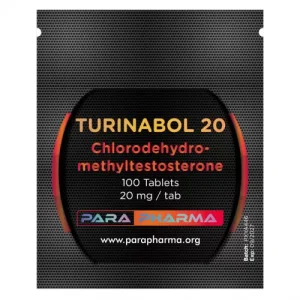 Click Here to Buy: Turinabol 20 by Para Pharma
Click Here to Buy: Turinabol 20 by Para Pharma
CJC-1295: A peptide that increases growth hormone and IGF-1 levels, aiding in fat loss, muscle gain, and improved sleep quality. It has a long half-life, making it convenient for users.
HGH Frag 176-191: A fragment of human growth hormone specifically designed for fat-burning. It targets adipose tissue without the broader effects of full-length HGH.
Tesamorelin: Known for reducing visceral fat, this peptide stimulates the release of growth hormone and is often used for weight management and metabolic health.
BPC-157: While primarily known for healing and recovery, BPC-157 can support fat loss indirectly by improving gut health and reducing inflammation.
Melanotan II: Originally developed for skin tanning, it also has appetite-suppressing properties, making it useful for weight management.
Thymosin Beta-4 (TB-500): Focused on healing and recovery, it can enhance physical performance and indirectly support fat loss through improved activity levels.
GHRP-6: A growth hormone-releasing peptide that boosts appetite and metabolism, aiding in muscle growth and fat loss.
Semaglutide: A GLP-1 receptor agonist that regulates appetite and blood sugar levels, making it effective for weight loss and metabolic health.
MK-677 (Ibutamoren): A growth hormone secretagogue that increases growth hormone and IGF-1 levels, promoting fat loss, muscle gain, and improved recovery.
List of Peptides With a Counteractive Effect Bodybuilders Must Avoid
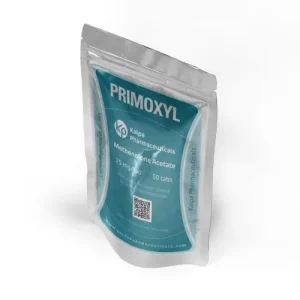 Click Here to Buy Primoxyl 25 by Kalpa Pharmaceuticals
Click Here to Buy Primoxyl 25 by Kalpa Pharmaceuticals
Some peptides can inadvertently lead to fat gain due to their effects on metabolism and appetite regulation. Here are a few that bodybuilders might want to avoid or use cautiously:
- GHRP-6 – While it stimulates growth hormone release, it also significantly increases appetite, which can lead to excess calorie consumption and fat gain.
- IGF-1 LR3 – This peptide enhances muscle growth but can also promote fat storage if not carefully managed with diet and training.
- MK-677 (Ibutamoren) – Though technically a growth hormone secretagogue rather than a peptide, it boosts GH levels but often leads to increased hunger and potential fat accumulation.
- CJC-1295 with DAC – While effective for muscle growth, its prolonged GH release can sometimes lead to unwanted fat retention if not paired with a strict diet
Overall
AOD-9604, derived from Growth Hormone, stimulates fat-burning by targeting lipolysis—the breakdown of fat for energy. It delivers these benefits without the additional effects of Growth Hormone, making it more cost-effective. For maximum effectiveness, it should be administered in a fasted state, ideally before bed and again in the morning at 125-250mcg doses. Pairing its use with fasting and fasted cardio can further enhance fat loss. Its sole focus is on improving the body’s ability to burn fat efficiently.
Read More: How Much Do You Know About B-AET? A Fat Burner You’ve Been Missing
Bodybuilding
Understanding Trenbolone-Induced Cough (“Tren Cough”)
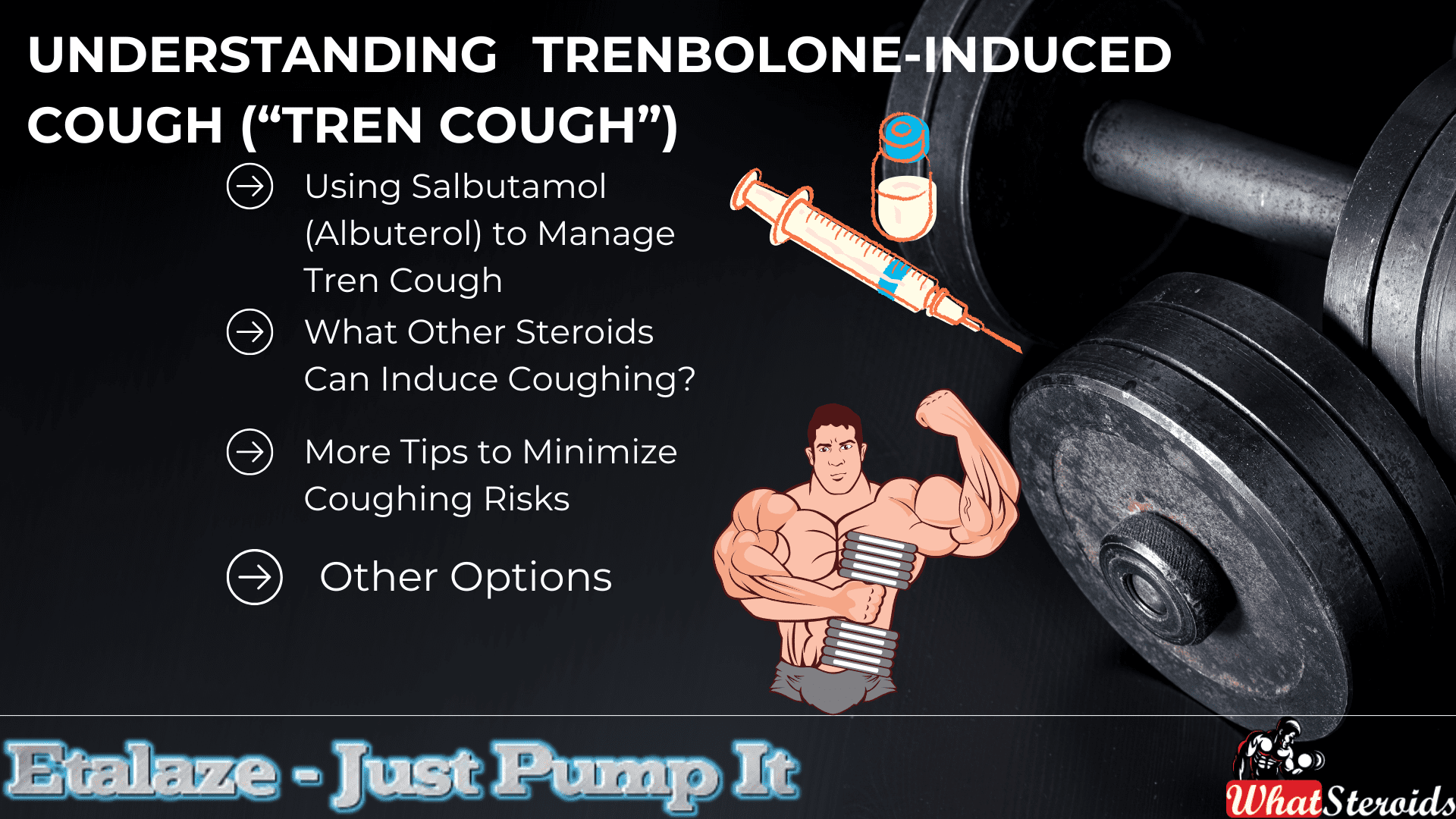
Trenbolone, a potent anabolic steroid, can sometimes cause “tren cough”—a sudden and intense coughing episode shortly after injection. Although not exclusive to Trenbolone, it is more commonly associated with this substance due to its highly irritant nature.
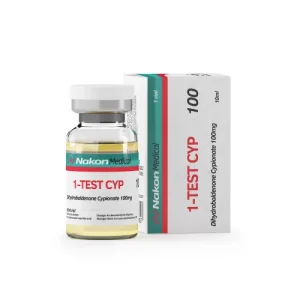 Click Here To Buy 1-Test Cyp 100 by Nakon Medical
Click Here To Buy 1-Test Cyp 100 by Nakon Medical
Mechanisms Behind Tren Cough
Solvent and Carrier Irritation
Trenbolone formulations often include volatile solvents like benzyl alcohol or benzyl benzoate, which may irritate lung tissues when absorbed quickly into systemic circulation.
Prostaglandin Release
Trenbolone promotes increased production of prostaglandins, particularly PGF2α. This compound triggers contraction in the smooth muscles of the lungs, leading to bronchoconstriction and coughing.
Micro-Oil Embolism
Tiny oil droplets from an injection can reach capillaries and travel to the lungs, causing mild embolic reactions that lead to temporary oxygen deprivation and coughing.
Histamine and Mast Cell Activation
For some individuals, Trenbolone triggers histamine release and mast cell activation, mimicking an allergic response and causing bronchospasms and cough reflexes.
Related Article: Best Syringes for Steroid Injection on Amazon
Using Salbutamol (Albuterol) to Manage Tren Cough
- Salbutamol, a widely-used β2-adrenergic receptor agonist, can alleviate tren cough symptoms by:
- Relaxing bronchial muscles, easing spasms that cause coughing.
- Inhibiting prostaglandin effects, reducing bronchoconstriction associated with PGF2α.
- Opening airways, preventing severe respiratory restrictions in susceptible individuals.
Application Methods
Inhaler (Optimal)
Take 1–2 puffs of salbutamol (100–200 mcg) 5–10 minutes before a Trenbolone injection. If coughing occurs afterward, additional puffs can swiftly resolve the issue.
Oral Tablets (Moderate)
Consuming 2–4 mg tablets 30–60 minutes before injection offers slower, longer-lasting relief but may be less effective than inhalation methods.
Nebulizer (Severe Cases)
For individuals with frequent episodes, nebulized doses of 2.5 mg salbutamol can provide substantial relief.
Preventive Measures to Reduce Tren Cough Risk
- Inject slowly to minimize systemic absorption and irritant effects.
- Split doses to lower reaction severity with smaller quantities.
- Opt for ventrogluteal injection sites, which have fewer blood vessels, reducing oil embolism risk.
- Choose lower-concentration solutions to lessen irritation, as higher concentrations (e.g., Tren Ace 200 mg/ml) are more likely to provoke reactions.
What Other Steroids Can Induce Coughing?
Here's a curated list of peptides, SARMs, and PEDs that may potentially cause coughing or respiratory irritation in bodybuilders and fitness enthusiasts:
Peptides
IGF-1 LR3 (Insulin-like Growth Factor): Known for its anabolic effects, IGF-1 LR3 can occasionally cause mild respiratory irritation due to systemic absorption.
TB-500 (Thymosin Beta-4): While rare, improper injection techniques or high doses may lead to transient coughing episodes.
GHRP-6 (Growth Hormone-Releasing Peptide): This peptide can stimulate histamine release, potentially leading to bronchospasms and coughing.
SARMs (Selective Androgen Receptor Modulators)
RAD-140: (Testolone) Some users report throat irritation or coughing, often attributed to solvents used in liquid formulations.
YK-11: Known for its myostatin-inhibiting properties, YK-11 may cause mild respiratory discomfort in sensitive individuals.
LGD-4033 (Ligandrol): Though uncommon, some users experience coughing due to carrier solvents or allergic-like reactions.
PEDs (Performance-Enhancing Drugs)
Boldenone Undecylenate (Equipoise): This injectable steroid can cause “Equipoise cough,” similar to tren cough, due to oil embolism or irritant solvents.
Testosterone Suspension: The water-based formulation may lead to coughing episodes if injected improperly or absorbed rapidly.
Nandrolone Decanoate (Deca-Durabolin): While less common, coughing can occur due to histamine release or systemic irritation.
More Tips to Minimize Coughing Risks
- Use proper injection techniques to avoid embolic reactions.
- Opt for lower-concentration solutions to reduce irritant effects.
- Consider antihistamines or bronchodilators for individuals prone to respiratory sensitivity.
Read More: Joint Stiffness: How to Manage It While on AAS
Are There Alternatives to Cough-inducing Steroids?
Here are some alternatives to cough-inducing steroids that can provide similar anabolic effects while minimizing respiratory irritation:
Peptides
IGF-1 LR3 (Insulin-like Growth Factor)
Promotes muscle growth and recovery without the irritant properties of certain steroids.
TB-500 (Thymosin Beta-4)
Enhances tissue repair and reduces inflammation, making it a safer option for recovery.
BPC-157 (Body Protection Compound)
Known for its healing properties, it supports muscle repair and joint health.
SARMs (Selective Androgen Receptor Modulators)
RAD-140 (Testolone)
Provides significant muscle-building effects with fewer systemic side effects compared to traditional steroids.
LGD-4033 (Ligandrol)
Boosts lean muscle mass and strength without the risk of respiratory irritation.
MK-677 (Ibutamoren)
Stimulates growth hormone release, aiding in muscle growth and recovery.
Natural Alternatives
Turkesterone
A plant-based ecdysteroid that supports muscle protein synthesis and recovery.
Ecdysterone
Another natural compound that mimics anabolic effects without the harsh side effects.
Creatine Monohydrate
Enhances strength and muscle mass through improved energy production during workouts.
Other Options
Human Growth Hormone (HGH)
Promotes muscle growth and fat loss, though it requires careful monitoring due to potential side effects.
Testosterone Boosters
Natural supplements like D-Aspartic Acid or Tribulus Terrestris can help optimize testosterone levels for muscle growth.
SARMs Alternatives
Legal and safer versions of SARMs are available, offering similar benefits without the risks associated with traditional SARMs.
Overall
We have explored the phenomenon of "tren cough," a sudden, intense coughing episode often caused by Trenbolone injections due to factors like solvent irritation, prostaglandin release, micro-oil embolism, or histamine activation. Preventive measures such as using salbutamol (via inhaler, oral tablets, or nebulizer), injecting slowly, splitting doses, and opting for lower-concentration solutions were highlighted.
Additionally, alternative compounds to tren cough-inducing steroids were discussed, including peptides like IGF-1 LR3 and TB-500, SARMs such as RAD-140 and LGD-4033, and natural options like Turkesterone, ecdysterone, and creatine. These alternatives provide anabolic effects while minimizing respiratory side effects. The conversation also underscored the importance of proper injection techniques and thoughtful compound selection to reduce risks.
-
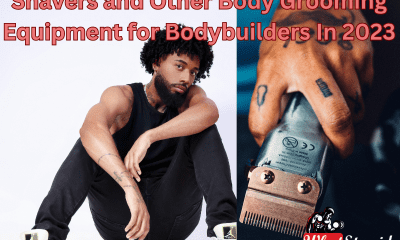
 Steroids2 years ago
Steroids2 years agoShavers and Other Body Grooming Equipment for Bodybuilders In 2023
-
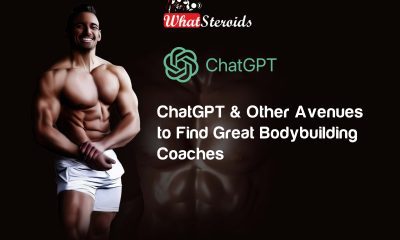
 Steroids2 years ago
Steroids2 years agoChatGPT and Other Avenues to Find Great Bodybuilding Coaches
-
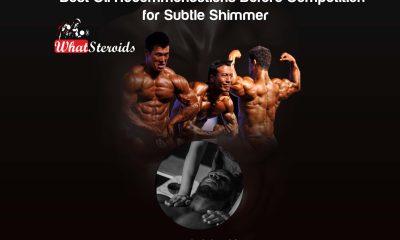
 Steroids2 years ago
Steroids2 years agoBest Oil Recommendations Before Competition for Subtle Shimmer
-
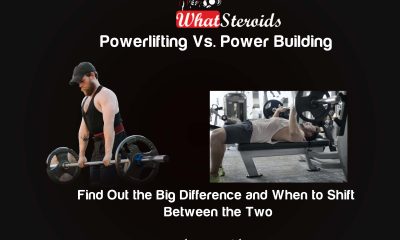
 Steroids2 years ago
Steroids2 years agoPowerlifting Vs Power Building: Find Out the Big Difference and When to Shift Between the Two
-

 Nutrition2 years ago
Nutrition2 years agoEverything Nutritional Food: What’s Too Much Or Too Little
-

 Bodybuilding Products1 year ago
Bodybuilding Products1 year agoTelmisartan In Bodybuilding: An Expert’s Advice
-
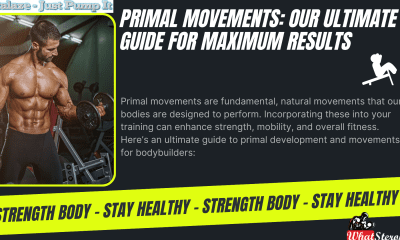
 Bodybuilding9 months ago
Bodybuilding9 months agoPrimal Movements: Our Ultimate Guide for Maximum Results
-

 Bodybuilding1 year ago
Bodybuilding1 year agoChia Seeds in A Bodybuilder’s Diet: An Expert’s Advice
-

 Anabolic Steroids10 months ago
Anabolic Steroids10 months agoJoint Stiffness: How to Manage It While on AAS
-

 Steroids1 year ago
Steroids1 year agoAnadrol Cycle: Benefits, Doses, Alternatives, etc.
-

 Anabolic Steroids1 year ago
Anabolic Steroids1 year agoLegality of Anabolic Steroids In Latin America
-

 Beginners2 years ago
Beginners2 years agoTren Cycle for Beginners
-

 Bodybuilding9 months ago
Bodybuilding9 months agoHow Effective is Bone Broth for Recovery?
-

 Steroids10 months ago
Steroids10 months agoOmnitope (Oxytocin)
-

 Bodybuilding1 year ago
Bodybuilding1 year agoHow Much Is Too Much Cardio? Understanding Heart Rate Zones
-

 Steroids9 months ago
Steroids9 months agoSleeping Positions for Effective Muscle Recovery
-

 Bodybuilding1 year ago
Bodybuilding1 year agoList of FDA-Approved Peptides
-

 Bodybuilding2 years ago
Bodybuilding2 years agoCompetition Prep Cycle for Pro Bodybuilders
-

 Bodybuilding1 year ago
Bodybuilding1 year agoCalorie Dumping: A Bodybuilder’s Guide
-

 Bodybuilding8 months ago
Bodybuilding8 months ago2nd Edition of Natural Bodybuilding Competition Facts
-

 Bodybuilding1 year ago
Bodybuilding1 year agoDemystifying Hypertrophy Training
-

 Bodybuilding9 months ago
Bodybuilding9 months agoAre Nootropics a Better Option to AAS?
-

 Anabolic Steroids12 months ago
Anabolic Steroids12 months agoHow Much Do You Know About B-AET? A Fat Burner You’ve Been Missing
-

 Steroids4 months ago
Steroids4 months agoOstarine For Beginners: The Ultimate Guide
-

 Product Reviews12 months ago
Product Reviews12 months agoTop Vitamins for Skin Health


























